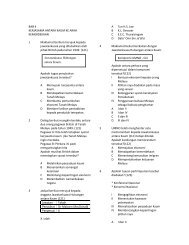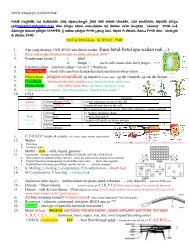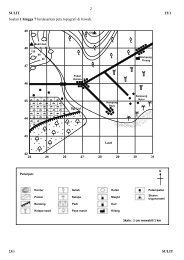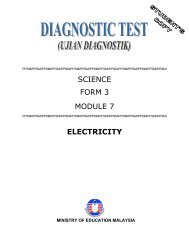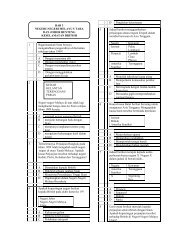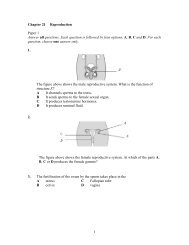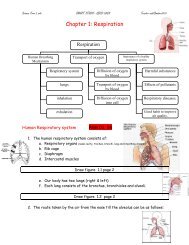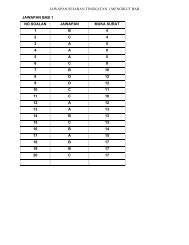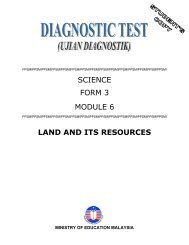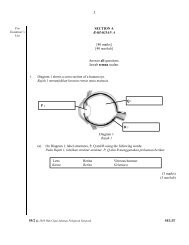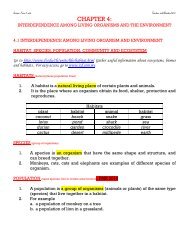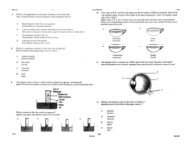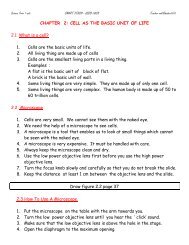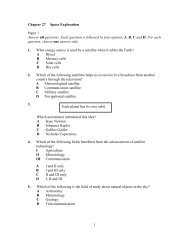SCIENCE FORM 3 MODULE 1 RESPIRATION
SCIENCE FORM 3 MODULE 1 RESPIRATION
SCIENCE FORM 3 MODULE 1 RESPIRATION
You also want an ePaper? Increase the reach of your titles
YUMPU automatically turns print PDFs into web optimized ePapers that Google loves.
PPSMIPPSMIPPSMIPPSMIPPSMIPPSMIPPSMIPPSMIPPSMIPPSMIPPSMIPPSMIPPSMIPPSMIPPSMI<br />
<strong>SCIENCE</strong><br />
<strong>FORM</strong> 3<br />
<strong>MODULE</strong> 1<br />
PPSMIPPSMIPPSMIPPSMIPPSMIPPSMIPPSMIPPSMIPPSMIPPSMIPPSMIPPSMIPPSMIPPSMIPPSMI<br />
<strong>RESPIRATION</strong><br />
MINISTRY OF EDUCATION MALAYSIA
<strong>MODULE</strong> 1: <strong>RESPIRATION</strong><br />
Arahan:<br />
1. Modul ini mengandungi tiga puluh empat soalan. Semua soalan adalah dalam<br />
bahasa Inggeris.<br />
2. Modul merangkumi enam konstruk yang diuji<br />
K1-Memahami soalan dalam Bahasa Inggeris<br />
K3-Memahami istilah sains dalam Bahasa Inggeris<br />
K5-Menguasai konstruk pengetahuan<br />
K6-Menguasai konstruk kefahaman<br />
K7-Menguasai konstruk kemahiran<br />
K10-Memahami pengajaran dan pembelajaran dalam Bahasa Inggeris<br />
3. Murid hendaklah menulis maklumat diri dalam kertas jawapan objektif<br />
disediakan. Murid juga perlu memastikan maklumat konstruk, nombor soalan dan<br />
jumlah soalan seperti yang dibaca oleh guru di dalam ruangan disediakan dalam<br />
kertas jawapan objektif sebelum ujian.<br />
4. Bagi soalan objektif, anda perlu menandakan jawapan dengan menghitamkan<br />
pilihan jawapan pada pilihan jawapan A , B , C atau D pada kertas jawapan<br />
objektif.<br />
Contoh:<br />
Antara berikut, yang manakah haiwan?<br />
A. Pokok B. Kambing C. Kereta D. Pen<br />
A B C D<br />
E<br />
5. Untuk soalan subjektif, jawapan hendaklah ditulis pada kertas berasingan<br />
yang disediakan oleh guru.<br />
6. Bagi soalan 29 - 34, soalan dikemukakan secara lisan oleh guru manakala<br />
jawapan diberi secara bertulis oleh murid.<br />
7. Jawab semua soalan.<br />
Modul ini mengandungi 19 halaman bercetak<br />
2
1 The figure shows the respiratory system<br />
Which of the following is part of the respiratory system?<br />
A<br />
B<br />
C<br />
D<br />
Kidney<br />
Stomach<br />
Lungs<br />
Heart<br />
2 Inhalation and exhalation compliments each other.<br />
During exhalation, the air pressure in our thoracic cavity is greater than the air<br />
pressure outside our body. When we inhale, the air pressure in the thoracic<br />
cavity is _________ than the air pressure outside the body.<br />
A<br />
B<br />
C<br />
more<br />
equal<br />
less
3 Oxyhaemoglobin is formed when haemoglobin combines with oxygen. Which<br />
of the following describes the above statement?<br />
A<br />
B<br />
C<br />
D<br />
Oxygen reacts with haemoglobin<br />
Oxygen joins with haemoglobin<br />
Oxygen dissolves in haemoglobin<br />
Oxygen separates from haemoglobin<br />
4<br />
Gas exchange occurs in alveolus. Gases involved in the process<br />
are oxygen and carbon dioxide<br />
Which gases are involved in gas exchange process?<br />
I<br />
II<br />
III<br />
A<br />
B<br />
C<br />
D<br />
Oxygen<br />
Carbon dioxide<br />
Nitrogen<br />
I and II<br />
I and III<br />
II and III<br />
I, II and III<br />
4
5 The figure shows the model of breathing mechanism<br />
Balloons deflate<br />
Balloons inflate<br />
What is the process shown by the figure?<br />
A<br />
B<br />
C<br />
D<br />
Inhalation<br />
Respiration<br />
Exhalation<br />
Diffusion<br />
6 Nicotine and tar found in cigarette smoke can cause cancer. These<br />
substances are known as _______________<br />
A<br />
B<br />
C<br />
D<br />
detergent<br />
preservatives<br />
pollutant<br />
carcinogen<br />
5
7 The figure shows the transportation of oxygen from blood capillary into the<br />
body cells<br />
nucleus<br />
cell<br />
blood capillary<br />
red blood cell<br />
Name the process represented by the arrows<br />
A<br />
B<br />
C<br />
D<br />
Combustion<br />
Respiration<br />
Diffusion<br />
Oxidation<br />
8 The intake of air into the lungs is called __________<br />
A<br />
B<br />
C<br />
D<br />
breathing<br />
inhaling<br />
exhaling<br />
respiring<br />
6
9 The figure shows organs in human body.<br />
A<br />
C<br />
B<br />
D<br />
Smoking will cause diseases in our respiratory system. Choose the organ<br />
which will be affected by smoking.<br />
10 What is the system that enables us to breathe?<br />
A<br />
B<br />
C<br />
Circulatory<br />
Respiratory<br />
Excretory<br />
7
11 Name a gas in the air that diffuses into the blood capillaries from the alveolus.<br />
A<br />
B<br />
C<br />
D<br />
Nitrogen<br />
Carbon dioxide<br />
Carbon monoxide<br />
Oxygen<br />
12 The figure shows a human respiratory system.<br />
Which of the following parts represents the alveolus?<br />
A<br />
C<br />
B<br />
D<br />
8
13 The figure shows a human respiratory system.<br />
Rib<br />
Lung<br />
Thoracic<br />
Diaphragm<br />
Cavity<br />
Which physical change does not occur during exhalation?<br />
A<br />
B<br />
C<br />
D<br />
Thoracic cavity become smaller<br />
Rib cage move downwards and inwards<br />
Diaphragm moves up<br />
Diaphragm moves down<br />
9
14 During gaseous exchange, the oxygen and carbon dioxide pass through the<br />
wall of alveolus.<br />
Which of the following are the possible characteristics of the wall of alveolus?<br />
I<br />
II<br />
III<br />
IV<br />
A<br />
B<br />
C<br />
D<br />
Thin<br />
Thick<br />
Dry<br />
Moist<br />
I and II<br />
I and III<br />
I and IV<br />
I, II and III<br />
15 The figure shows a human respiratory system.<br />
Which of the following are diseases that affect the human respiratory system?<br />
I<br />
II<br />
III<br />
IV<br />
Pneumonia<br />
Bronchitis<br />
Asthma<br />
Hepatitis<br />
A<br />
B<br />
C<br />
D<br />
I and II only<br />
II and IV only<br />
I, II and III<br />
I, III and IV<br />
10
16 The figures show the systems found in a human body.<br />
In which system does inhalation take place?<br />
A<br />
B<br />
C<br />
D<br />
17 Which of the following are examples of harmful substances found in cigarette<br />
smoke?<br />
I<br />
II<br />
III<br />
IV<br />
Carbon monoxide<br />
Nicotine<br />
Tar<br />
Sulphur dioxide<br />
A<br />
B<br />
C<br />
D<br />
I and II only<br />
I and III only<br />
I,II and III only<br />
I, II, III and IV<br />
11
18 The alveolus wall is very thin to make it easier for ______________<br />
A<br />
B<br />
C<br />
D<br />
gas diffusion<br />
gas absorption<br />
blood absorption<br />
blood diffusion<br />
19 The figure shows the structure of alveolus in a lung.<br />
At which vessel does the oxygenated blood flow?<br />
A<br />
B<br />
C<br />
20 During gaseous exchange in the alveolus, the diffusion process involves<br />
___________<br />
I<br />
II<br />
III<br />
IV<br />
the flow of oxygen from the blood capillaries into the alveolus<br />
the flow of carbon dioxide from the alveolus into the blood capillaries<br />
the flow of oxygen from the alveolus into the blood capillaries<br />
the flow of carbon dioxide from the blood capillaries into the alveolus<br />
A<br />
B<br />
C<br />
D<br />
I and II<br />
II and III<br />
III and IV<br />
I, II, III and IV.<br />
12
21 Which of the following statements is correct about the breathing mechanism?<br />
A<br />
B<br />
C<br />
D<br />
The air pressure in the lungs increases during inhalation<br />
The air pressure in the lungs decreases during exhalation<br />
The thoracic cavity becomes smaller during exhalation<br />
The thoracic cavity becomes smaller during inhalation<br />
22 Which of the following is a factor which speeds up the gaseous exchange in<br />
the lungs?<br />
I<br />
II<br />
III<br />
There are thousands of alveoli in the lungs<br />
The total surface area of alveoli is small<br />
There is a rich network of capillaries in the alveoli<br />
A<br />
B<br />
C<br />
D<br />
I and II only<br />
I and III only<br />
II and III only<br />
I, II and III<br />
13
23 The figure shows the model of a respiratory system.<br />
Glass jar<br />
Balloon<br />
Rubber sheet<br />
What will happen when the rubber sheet is pushed upward?<br />
I<br />
II<br />
III<br />
Both the balloons will deflate<br />
The air pressure in the glass jar will increase<br />
The density of the air in the glass jar will increase<br />
A<br />
B<br />
C<br />
D<br />
I and II<br />
I and III<br />
II and III<br />
I, II and III<br />
24 Which of the following shows the correct concentration of oxygen and carbon<br />
dioxide during inhalation?<br />
Concentration of oxygen Concentration of carbon dioxide<br />
A Low High<br />
B Low Low<br />
C High Low<br />
D High Low<br />
14
25 The figure shows a human respiratory system.<br />
S<br />
P<br />
T<br />
Q<br />
R<br />
Which of the following represents the flow of air from the lungs to the<br />
atmosphere?<br />
A<br />
B<br />
C<br />
D<br />
RQPTS<br />
RQTPS<br />
SPTQR<br />
STPQR<br />
15
26 The table shows the comparison between inhalation and exhalation in<br />
breathing mechanism.<br />
Inhalation<br />
Exhalation<br />
I Diaphragm moves down Diaphragm moves up<br />
II<br />
III<br />
Volume of the thoracic cavity<br />
increases<br />
Air pressure in the thoracic<br />
cavity decreases<br />
Volume of the thoracic cavity<br />
decreases<br />
Air pressure in the thoracic cavity<br />
increases<br />
Which of the following are correct?<br />
A<br />
B<br />
C<br />
D<br />
I and II<br />
I and III<br />
II and III<br />
I, II and III<br />
16
27 The figure shows the apparatus set up to investigate the effects of smoking on<br />
the lungs.<br />
Which of the following can be observed when the filter pump is switched on<br />
for 5 minutes?<br />
I<br />
II<br />
III<br />
IV<br />
The temperature in the thermometer rises<br />
The cotton wool will become brown<br />
The air pressure in the U-tube increases<br />
The bicarbonate indicator turns yellow<br />
A<br />
B<br />
C<br />
D<br />
I and II<br />
II and III<br />
I, II and IV<br />
II, III and IV<br />
17
28 P, Q, R and S are the processes that take place when oxygen enters the<br />
blood capillaries.<br />
P<br />
The oxygen diffuses into the body cells<br />
Q Oxygen combines with haemoglobin in the red blood cells to<br />
form oxyhaemoglobin<br />
R Oxygenated blood is transported to the body cells<br />
S The oxygenated blood reaches the body cells,<br />
oxyhaemoglobin decomposes to release oxygen<br />
Which of the following is the correct sequence of the processes?<br />
A<br />
B<br />
C<br />
D<br />
PQRS<br />
RQSP<br />
QRSP<br />
SQRP<br />
Listen carefullly to the text read by the teacher. Answer question 29 to 34.<br />
29 Which of the statements is correct?<br />
I<br />
II<br />
III<br />
IV<br />
A<br />
B<br />
C<br />
D<br />
The breathing mechanism involves physical changes of the respiratory<br />
system<br />
The breathing mechanism involves the chemical changes of the<br />
respiratory system<br />
Physical changes in the respiratory system enable us to breathe<br />
Physical changes in the respiratory system enable us to reproduce<br />
I and IV<br />
II and III<br />
I and III<br />
II and IV<br />
18
30 Based on the information above, which of the following statements is correct?<br />
A<br />
B<br />
C<br />
Inhalation is the process by which air is forced out of our lungs.<br />
Exhalation is the process by which air is forced into our lungs<br />
Inhalation is the process by which air is forced into our lungs<br />
31 Choose the correct statement.<br />
I<br />
II<br />
III<br />
IV<br />
A<br />
B<br />
C<br />
D<br />
The wall of alveolus is only one cell thick<br />
The wall of blood capillary is only one cell thick<br />
The wall of alveolus is thick<br />
The wall of blood capillary is thick<br />
I and II only<br />
II and III only<br />
I and IV only<br />
I, II, III and IV<br />
32 How many ways are there to improve the air quality?<br />
A Less than four<br />
B More than four<br />
C Equal to four<br />
33 Choose the correct statement.<br />
A Only cigarette smoke is harmful to the respiratory system<br />
B Burning of fossil fuels harms the respiratory system<br />
C Smoke from the vehicles does not harm the respiratory system<br />
34 Diseases that can be prevented by not smoking are __________<br />
A bronchitis and asthma<br />
B emphysema and pneumonia<br />
C lung cancer and bronchitis<br />
D asthma and influenza<br />
19
KEMENTERIAN PELAJARAN MALAYSIA<br />
KERTAS JAWAPAN OBJEKTIF<br />
Ujian Diagnostik<br />
Nama Pelajar:<br />
Tahun/ Tingkatan : 3 Mata Pelajaran: SAINS<br />
Nama Sekolah: Modul: 1<br />
GUNAKAN PENSIL 2B ATAU BB SAHAJA.<br />
TENTUKAN TIAP-TIAP TANDA ITU HITAM DAN MEMENUHI KESELURUHAN RUANG.<br />
PADAMKAN HINGGA HABIS MANA-MANA TANDA YANG ANDA UBAH<br />
SILA HITAMKAN JAWAPAN DI BAWAH MENGIKUT HURUF JAWAPAN YANG ANDA PILIH<br />
1<br />
2<br />
A B C D E<br />
A B C D E<br />
31<br />
32<br />
A B C D E<br />
A B C D E<br />
46<br />
47<br />
A B C D E<br />
A B C D E<br />
3<br />
4<br />
A B C D E<br />
A B C D E<br />
33<br />
34<br />
A B C D E<br />
A B C D E<br />
48<br />
49<br />
A B C D E<br />
A B C D E<br />
5<br />
A B C D E<br />
35<br />
A B C D E<br />
50<br />
A B C D E<br />
6<br />
7<br />
A B C D E<br />
A B C D E<br />
36<br />
37<br />
A B C D E<br />
A B C D E<br />
51<br />
52<br />
A B C D E<br />
A B C D E<br />
8<br />
9<br />
A B C D E<br />
A B C D E<br />
38<br />
39<br />
A B C D E<br />
A B C D E<br />
53<br />
54<br />
A B C D E<br />
A B C D E<br />
10<br />
A B C D E<br />
40<br />
A B C D E<br />
55<br />
A B C D E<br />
11<br />
12<br />
A B C D E<br />
A B C D E<br />
41<br />
42<br />
A B C D E<br />
A B C D E<br />
56<br />
57<br />
A B C D E<br />
A B C D E<br />
13<br />
14<br />
15<br />
A B C D E<br />
A B C D E<br />
A B C D E<br />
43<br />
44<br />
45<br />
A B C D E<br />
A B C D E<br />
A B C D E<br />
58<br />
59<br />
60<br />
A B C D E<br />
A B C D E<br />
A B C D E<br />
16<br />
17<br />
A B C D E<br />
A B C D E<br />
Konstruk No. Soalan Jumlah<br />
Soalan<br />
Bilangan Soalan<br />
Gagal Dijawab<br />
Kegunaan Guru<br />
18<br />
19<br />
20<br />
A B C D E<br />
A B C D E<br />
A B C D E<br />
1<br />
2<br />
K1<br />
K3<br />
1-4<br />
5-8<br />
4<br />
4<br />
21<br />
22<br />
A B C D E<br />
A B C D E<br />
3<br />
4<br />
K5<br />
K6<br />
9-14<br />
15-24<br />
6<br />
10<br />
23<br />
24<br />
25<br />
A B C D E<br />
A B C D E<br />
A B C D E<br />
5<br />
6<br />
K7<br />
K10<br />
25-28<br />
29-34<br />
6<br />
4<br />
26<br />
A B C D E<br />
7<br />
27<br />
28<br />
29<br />
A B C D E<br />
A B C D E<br />
A B C D E<br />
8<br />
9<br />
30<br />
A B C D E<br />
10<br />
20



